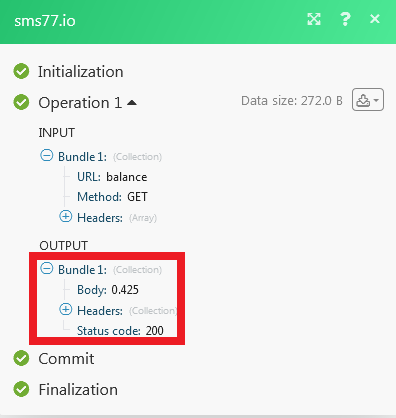The sms77 modulesThe module is an application or tool within the Boost.space system. The entire system is built on this concept of modularity. (module - Contacts) More allow you to send SMS, check messages statusCreate statuses for each module separately to create an ideal environment for efficient and consistent work. More, check account balance and pricing, send a voice message, and lookup HLR, MNP, and CNAM information in your sms77 account.
Prerequisites
-
An sms77 account
In order to use sms77 with Boost.spaceCentralization and synchronization platform, where you can organize and manage your data. More IntegratorPart of the Boost.space system, where you can create your connections and automate your processes. More, it is necessary to have an sms77 account. If you do not have one, you can create an sms77 account at sms77/signup.
![[Note]](https://bs-docs2.boost.space/wp-content/themes/bsdocs/docs-parser/HTML/css/image/note.png) |
Note |
|---|---|
|
The moduleThe module is an application or tool within the Boost.space system. The entire system is built on this concept of modularity. (module - Contacts) More dialog fields that are displayed in bold (in the Boost.space Integrator scenarioA specific connection between applications in which data can be transferred. Two types of scenarios: active/inactive. More, not in this documentation article) are mandatory! |
To connect your sms77 account to Boost.space Integrator, you need to obtain your API Key.
1. Login to your sms77 account.
2. From the left menu, click Settings and then click HTTPS API.
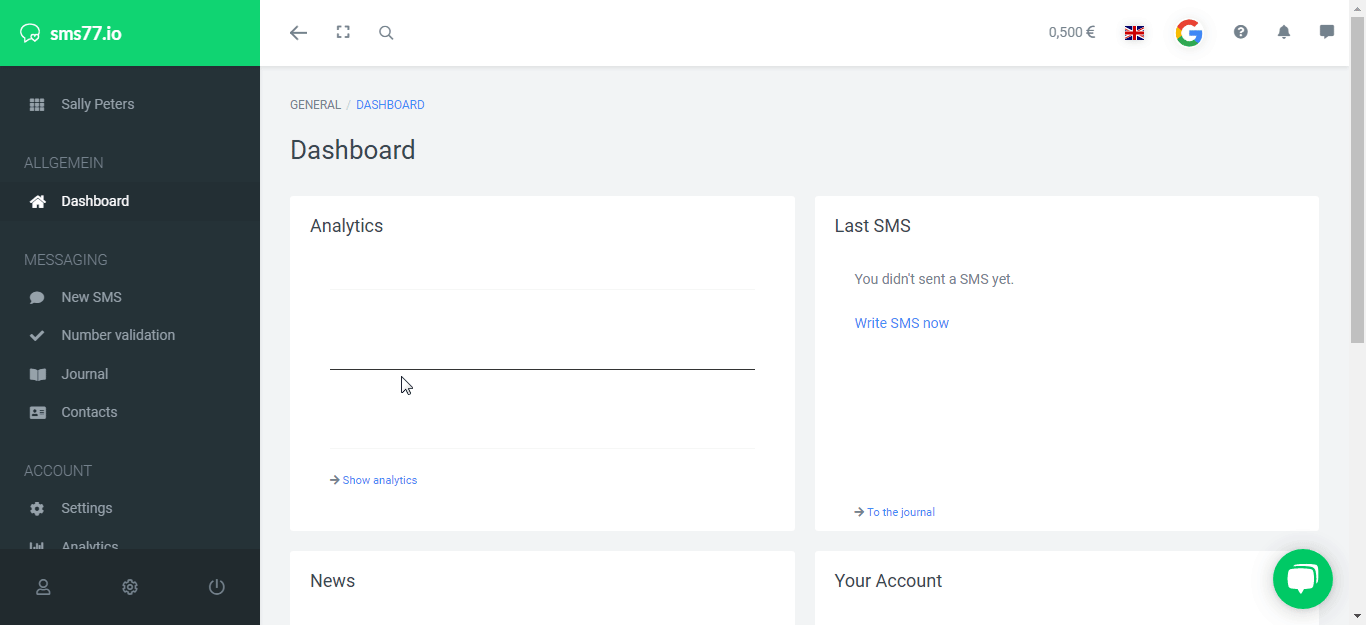
3. Copy the API Key to your clipboard.

4. Go to Boost.space Integrator and open the sms77 module’s Create a connectionUnique, active service acces point to a network. There are different types of connections (API key, Oauth…). More dialog.
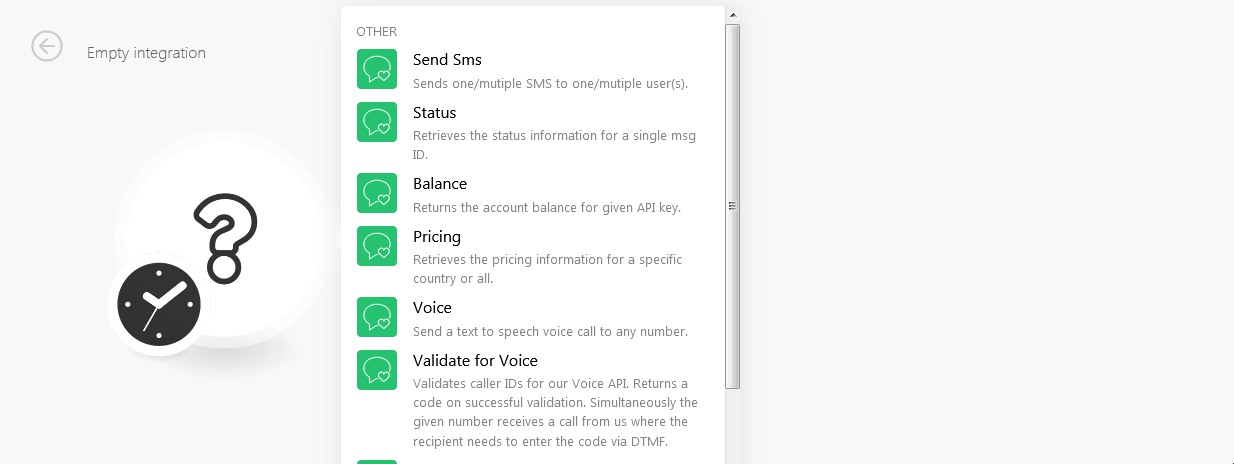
5. In the Connection name field, enter a name for the connection and click Continue.
6. In the API Key field, enter the API key copied in step 3.
7. Click Continue.
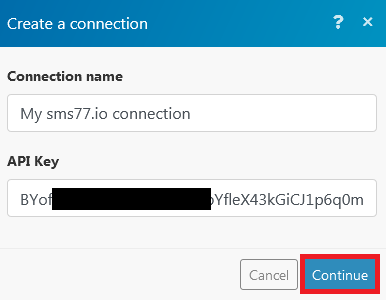
The connection has been established.
Sends one/multiple SMS to one/multiple user(s).
|
Connection |
|
|
Message |
Enter the message text. |
|
Recipient |
Enter the recipient’s phone number. |
|
Debug |
Select whether you want to send the SMS and charge the account:
|
|
Delay |
Enter the date and time when you want to send the message. For example, |
|
Flash |
Select whether to send SMS as a flash:
|
|
From |
Enter the name or phone number that displays to the recipient. |
|
LabelA label is a “tag” that can be added to items within a module. It's a flexible tool used to categorize and organize data, making it easier to customize workflows and processes. More |
Enter a label for the message to filter the messages when searching. For example, |
|
No Reload |
Select whether to send duplicate SMS within a timeframe of 180 seconds:
|
|
Performance Tracking |
Select whether to active performance tracking for URLs found inside the message. |
|
Time to Live |
Enter the time in milliseconds after which you do not want the message to be delivered. |
|
Type |
Select the SMS type:
|
|
UserCan use the system on a limited basis based on the rights assigned by the admin. More data Header (UDH) |
Select whether to send SMS with custom User Data Header (UDH). If set and parameter text contains hex code, the SMS is sent as 8-bit binary SMS. Only direct SMS support custom UDH:
|
|
Unicode |
Select whether the message contains any encoding characters:
|
|
UTF8 |
Select whether you want to disable the automatic message format detection from the server and enforces the message(s) as UTF8:
|
Retrieves the status information for a single message ID.
|
Connection |
|
|
Message ID |
Enter the Message ID whose status you want to retrieve. |
Returns the account balance for a given API key.
|
Connection |
Retrieves the pricing information for a specific country or all.
|
Connection |
|
|
ISO Code |
Enter the ISO code to retrieve the pricings |
|
SMS Type |
Select the SMS type for which you want to view the pricing details:
|
Send a text to a speech voice call to any number.
|
Connection |
|
|
Recipient |
Enter the phone number of the recipient. |
|
Message |
Enter the message in the text that needs to be converted to voice. |
|
XML |
Select whether the recipient details are in XML format:
|
|
Sender |
Enter the sender number. |
Validates caller IDs for our voice API. Returns a code on successful validation. Simultaneously the given number receives a call from us where the recipient needs to enter the code via DTMF.
|
Connection |
|
|
Phone number |
Enter the phone number whose Caller ID you want to validate. |
|
Callback URL |
Enter the callback URL to call the phone number to validate the Caller ID. |
Looks up publicly available information about a phone number.
|
Connection |
|
|
Phone Number |
Enter the phone number whose details you want to lookup. |
Performs a Home Location Register (HLR) lookup.
|
Connection |
|
|
Phone Number |
Enter the phone number whose HLR information you want to lookup. |
Performs a Mobile Number Portability (MNP) lookup.
|
Connection |
|
|
Phone Number |
Enter the phone number whose MNP information you want to lookup. |
Performs a Calling Name Delivery lookup.
|
Connection |
Establish a connection to your sms77 account. |
|
Phone Number |
Enter the phone number whose Caller ID information you want to lookup. |
Performs an arbitrary authorized API call.
|
Connection |
||||
|
URL |
Enter a path relative to
|
|||
|
Method |
Select the HTTP method you want to use: GET to retrieve information for an entry. POST to create a new entry. PUT to update/replace an existing entry. PATCH to make a partial entry update. DELETE to delete an entry. |
|||
|
Headers |
Enter the desired request headers. You don’t have to add authorization headers; we already did that for you. |
|||
|
Query String |
Enter the request query string. |
|||
|
Body |
Enter the body content for your API call. |
The following API call returns balance amount in your sms77 account:
URL: balance
Method: GET
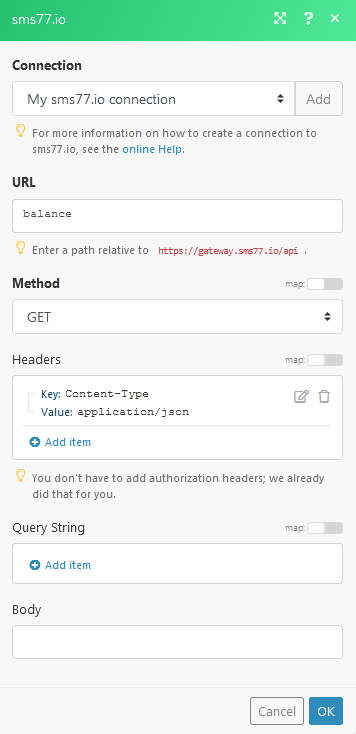
Matches of the search can be found in the module’s Output under BundleA bundle is a chunk of data and the basic unit for use with modules. A bundle consists of items, similar to how a bag may contain separate, individual items. More > Body. In our example, the balance amount in the sms77 account is returned:
